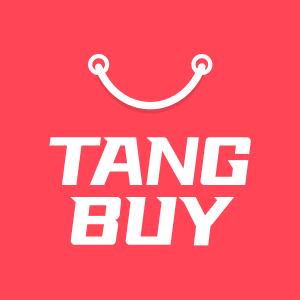How to Start Dropshipping for Beginners in 2025
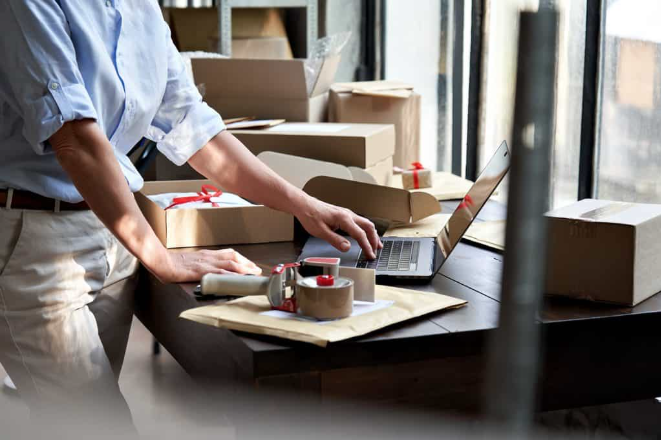
If you want to start dropshipping in 2025, you just need an idea and a laptop. You can begin your dropshipping business with little money. You do not need to store or ship products yourself. Many beginners try dropshipping because you can do it all online. You can focus on marketing. Suppliers will take care of the rest. In 2024, about 27% of online shops used this model. This shows it is popular for new businesses. This beginner guide will show you how to start. You do not need to have used shopify or sold online before. Dropshipping for beginners lets you start a business from anywhere. You can test new products and learn as you go. If you want to know how to start dropshipping, just take the first step. Shopify and other tools make it easy for anyone to begin. You do not need to be an expert at shopify. With this beginner guide, you will learn how to start, build, and run your own shopify store. Dropshipping for beginners is simple and flexible. It is great for anyone who wants to start a business online. Ready to try shopify and sell your first product? This beginner guide will help you learn how to start dropshipping and do well online.
Key Takeaways
Dropshipping lets you sell things online without keeping stock. This saves you money and work on storage and shipping.
Pick a clear niche with good products and suppliers you can trust. This helps you build a strong and honest dropshipping business.
Use tools like Shopify or WooCommerce to make your shop fast. These tools help you manage orders easily.
Give good customer service by talking clearly and handling returns well. Always keep your customers updated.
Start small and spend less by using free tools and trials. Grow your business by testing products and smart marketing.
Watch your profit margins and prices to keep your business making money. This also helps you stay ahead of others.
Make your brand strong with the same style and clear product pages. Try to offer special or branded products when you can.
Get ready for problems like supplier issues or late shipping. Have backup plans and clear rules to help you deal with them.
What is Dropshipping?
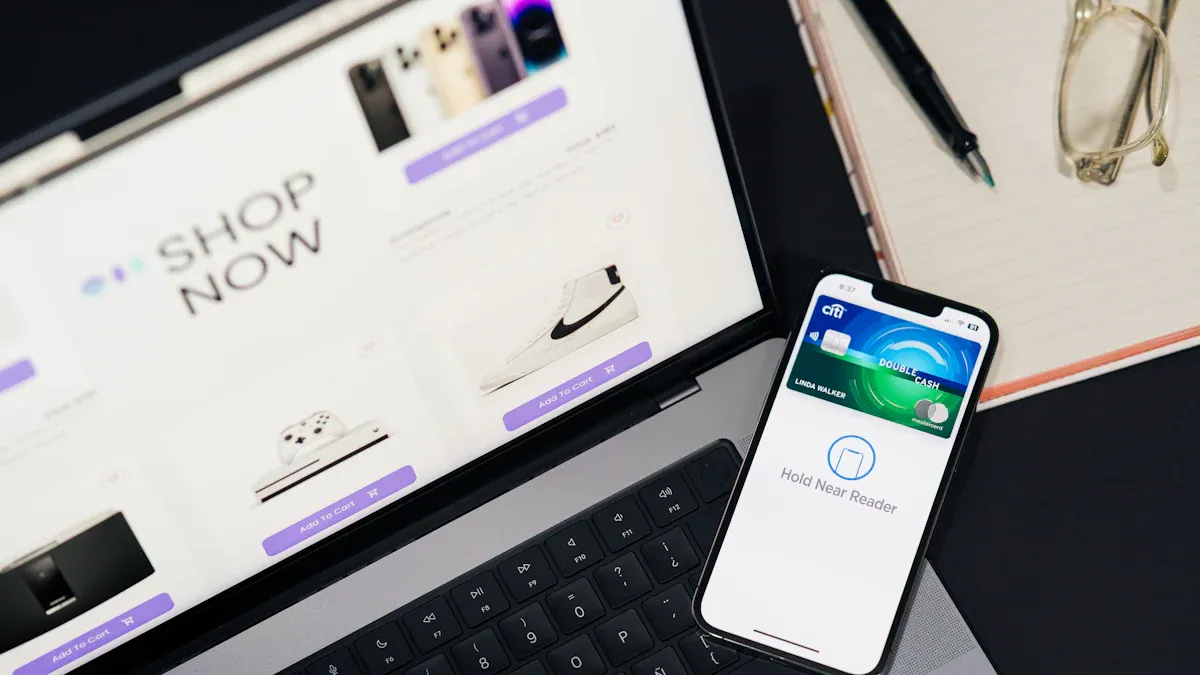
Simple Definition
Dropshipping is a way for you to sell products online without keeping any stock. You do not need to buy items before you sell them. When someone buys from your shop, you order the product from a supplier. The supplier then sends the product straight to your customer. You never see or touch the product yourself. This makes dropshipping easy for beginners who want to start an online business.
How It Works
Let’s break down how the dropshipping business model works:
You set up an online shop and list products you want to sell.
A customer places an order and pays you.
You forward the order details to your supplier and pay them.
The supplier ships the product directly to your customer.
You do not need to worry about storing products or packing boxes. The dropshipping business model is different from traditional e-commerce. In a normal online shop, you must buy stock, store it, and handle all the shipping. With dropshipping, you skip all that. You save money because you do not need a warehouse or lots of cash to buy products upfront. You can also offer more products without worrying about unsold stock.
Tip: Dropshipping lets you test new products quickly. If something does not sell, you can remove it from your shop with no loss.
Here’s a quick look at how dropshipping compares to traditional e-commerce:
Aspect | Dropshipping Model | Traditional E-commerce Model |
|---|---|---|
Inventory Management | No stock needed; supplier handles it | You buy and store your own stock |
Upfront Investment | Low | High |
Control Over Stock | Limited | Full control |
Risk | Low | High |
Scalability | Easy to scale | Harder to scale |
Shipping | Supplier ships to customer | You handle shipping |
Pros and Cons
Every business model has good and bad sides. Dropshipping is no different. Here are some things you should know:
Pros:
Low start-up costs. You do not need to buy stock first.
Easy to start. You can open a shop with little experience.
No need to manage inventory or shipping.
You can run your business from anywhere.
You can test many products without risk.
Cons:
Less control over product quality and stock levels.
Shipping times can be slow if your supplier is far away.
High competition. Many people try dropshipping, so profit margins can be low.
You must handle customer service, even if problems come from your supplier.
Harder to build a strong brand because you rely on suppliers.
Dropshipping gives you freedom and flexibility. You can start small and grow as you learn. Just remember, you need to choose good suppliers and keep your customers happy.
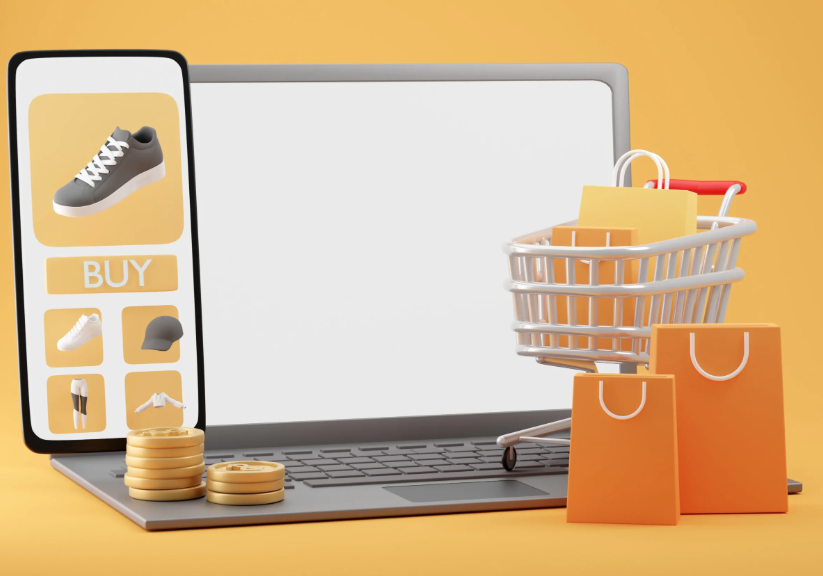
Is Dropshipping Profitable in 2025?

Market Trends
You might wonder if starting a dropshipping business in 2025 still makes sense. The answer is yes. The dropshipping market keeps growing every year. More people shop online, and more brands use the dropshipping business model to reach customers. You can see how big the market is getting in the table below:
Source | Year | Projected Market Size (USD Billion) | CAGR (%) |
|---|---|---|---|
Precedence Research | 2025 | 435 | 22.02 (2025-2034) |
Grand View Research | 2024 | 366 | 22 (2025-2030) |
Grand View Research | 2030 | 1254 | 22 (2025-2030) |
The numbers show strong growth. The dropshipping business model is not slowing down. More tools and platforms make it easier for you to start and run your own shop. You can find new products, test ideas, and reach customers all over the world.
Profit Margins
Profit is always important. In 2025, most dropshipping businesses see average profit margins between 10% and 30%. If you are just starting, aim for about 20%. This gives you room to cover costs and still make money. Margins can change based on what you sell, how much you spend on ads, and the fees from your selling platform. If your margin drops below 10%, your dropshipping business may not last long. You need to watch your expenses, like shipping, returns, and marketing. Many people think dropshipping is easy money, but you must plan your prices and costs carefully.
Tip: Always check your numbers. A successful dropshipping business keeps a close eye on profit margins and adjusts prices when needed.
What’s New in 2025
Dropshipping in 2025 looks different from a few years ago. New trends and technology help you stand out and grow your business. Here are some of the biggest changes:
Trend/Technology | Description |
|---|---|
Blockchain | Makes payments safer and builds trust with smart contracts. |
AI and Machine Learning | Helps you understand what customers want and improves your marketing. |
VR and AR | Lets shoppers try products online before they buy. |
Voice Commerce | More people use voice assistants to shop, so you need to think about voice search. |
Eco-Friendly and Sustainable Sourcing | Customers want green products and ethical suppliers. |
Localised Dropshipping | Using local suppliers means faster shipping and happier customers. |
Selling to a small, special group can mean higher profits. | |
Social Media & Short-Form Video | Platforms like TikTok help you reach more buyers with fun videos. |
You can use these trends to make your dropshipping business stand out. Try new tools, focus on what customers care about, and keep learning. The dropshipping business model keeps changing, so stay flexible and open to new ideas.
How to Start Dropshipping: Step-by-Step

Choose a Niche
You want to start dropshipping, but you may not know how. The first thing you need to do is pick your niche. This means you choose what kind of products you will sell. Your niche is important for your dropshipping business. If you choose well, it is easier to find good suppliers and customers. You can build a strong dropshipping business if you pick the right niche.
Here is an easy way to choose a good dropshipping niche in 2025:
Pick products that are strong and safe. These items get fewer returns and make customers happy.
Do not pick products that people often send back. Clothes with hard sizes can be a problem.
Stay away from products with legal or safety problems. Some things need special papers or are not allowed.
Look at your competition. Try to find products with less than 1,000 listings. Too many sellers can mean less money for you.
Read what customers say in reviews. See what they like and what they do not like.
Use market research tools like AMZScout. These tools help you see if people want your product and if you can make money.
Make sure you can sell your products on your chosen site. Some types of products have rules.
Choose a niche you like. You will enjoy your work more and spot new trends faster.
Use automation tools to save time and help your business grow.
Tip: Pick niches where sales are steady and customers are happy. Popular areas in 2025 are print on demand, health and beauty, and sustainable products. Niche dropshipping lets you try new products and change your shop quickly.
Research the Market
After you pick your niche, you need to learn about the market. This helps you know what sells and who your competitors are. It also helps you find ways to stand out. Good research is very important for a strong dropshipping business.
In 2025, there are many tools to help you with research. AI-powered tools can show you what is popular. You can use Inventory Source and Spocket to manage orders and stock. Marketing tools like Mailchimp and Meta Ads Manager help you reach people. Customer support tools like Zendesk and LiveChat help you keep buyers happy.
Here is a table with some of the best tools for market research in 2025:
Tool Name | Key Features and Benefits | Pricing/Access Model |
|---|---|---|
Tangbuy | Based on social media data such as TikTok and Instagram, intelligently screen potential best-selling products. Sourcing directly from top-tier Chinese manufacturers as well as platforms like 1688 and Taobao. | Free |
Integrates with AliExpress and 1688, offers US-based product dispatch, streamlines sourcing | SaaS platform, free and paid options | |
Exploding Topics | AI-driven trend monitoring, spots rising product trends early, affordable Pro membership | Subscription-based |
Dropship Spy | Focuses on AliExpress products, gives detailed product performance data | Subscription-based |
Helium10 | Over 30 tools for Amazon/Walmart sellers, Opportunity Score for product viability, free Chrome extension | Paid plans start at $80/month |
TikTok Creative Center | Shows trending product insights on TikTok, great for targeting younger shoppers | Free |
Thieve.co | Curates AliExpress products, offers free and premium plans | Freemium with paid upgrade |
You can use these tools to find trends and check what people want. Look for products that sell well and have good reviews. Watch for new trends like sustainable products or personalisation. Fast shipping and mobile shopping are also important in 2025.
Note: Always check if your marketplace has rules for your products. Some items need approval or are not allowed.

Find Reliable Suppliers
You cannot run a dropshipping business without good suppliers. They handle your products, shipping, and sometimes returns. If you want to do well, you must find a reliable supplier for every product. This guide for beginners will help you do that.
Supplier Platforms
Many platforms help you find dropshipping suppliers. Some focus on certain products or places. Others help you manage your shop and automate orders. Here is a table with some top supplier directories and platforms in 2025:
Supplier/Platform | Description | Key Features | Pricing Example |
|---|---|---|---|
Tangbuy | Tangbuy offers a full-stack sourcing and fulfillment solution. Users can search and purchase over 300,000 products at factory prices, customize items with private labels or packaging, and store inventory for up to 90 days for free in Tangbuy’s China warehouse. | Based on social media data such as TikTok and Instagram, intelligently screen potential best-selling products. Sourcing directly from top-tier Chinese manufacturers as well as platforms like 1688 and Taobao. | Free |
SaleHoo | Directory with 8,000+ vetted suppliers and 1.6 million products across 75 categories | Supplier verification, market research tools, product variety, wholesale guarantees | Membership fee (varies) |
Alibaba/AliExpress | Large marketplace with global shipping and a huge product range | Competitive prices, vast supplier base, easy integration with ecommerce platforms | Free to browse |
Worldwide Brands | Directory of certified wholesalers and dropshippers | Verified suppliers, broad product categories | N/A |
CJdropshipping | Product sourcing and fulfilment services | Store integration, automated order processing | N/A |
TheWholesaler.co.uk | UK-based wholesaler directory | Focus on UK suppliers, product variety | N/A |
eSources | UK wholesale directory with dropshipping options | Verified suppliers, multiple product categories | N/A |
WholesaleCentral | US-based wholesale directory | Large supplier database, free access | Free |
Toptenwholesale | Wholesale directory with dropshipping suppliers | Product variety, supplier verification | N/A |
Globalsources | China-based wholesale site focused on large orders and white labelling | Good for wholesalers, free access | Free |
Inventory Source | Dropship service with inventory and backend management | Integrates with Shopify, BigCommerce; supplier integration | Free - $150/month |
Doba | US dropshipping service with 2+ million products | Integrates with Amazon, eBay, Shopify; extensive product catalogue | $29/month |
Megagoods | Dropshipper specialising in electronics and video games | Blind dropshipping, US-made products | $14.99/month |
PlusBuyer | Chinese wholesaler specialising in electronics | Large selection, blind dropshipping | Free |
Modalyst | Focuses on high-quality and luxury brands | US and Europe suppliers, high vetting standards | $35/month |
Wholesale2B | Integration system with 1 million+ products | Integrates with multiple ecommerce platforms, educational resources | $37.99/month |
Sunrise Wholesale | US wholesaler since 1999, known for branded products | Product integration with major stores | $49/month |
You can also use AliExpress for many products and easy setup. Zendrop gives fast shipping and works with Shopify, but you pay a fee. SaleHoo is good for finding trusted suppliers and getting help. Wholesale2B lets you sell over a million products and works with many platforms.
Vetting Suppliers
You want a supplier you can trust, not just any supplier. Here is how to check your dropshipping suppliers:
Look at reviews and ratings. Pick suppliers with good feedback.
Order samples. Test the products before you sell them.
Ask about shipping times. Good suppliers give clear delivery dates and tracking.
Check how they talk to you. Good suppliers answer fast and help you.
Review return policies. Know how returns and refunds work.
Make sure they work with your ecommerce platform. Many dropshipping apps work with Shopify, WooCommerce, and others.
Tip: Always have a backup supplier for your best-selling products. This keeps your dropshipping business running if something goes wrong.
A guide for beginners always says you need good suppliers. If you want to start a dropshipping business and grow, you must build strong relationships with your suppliers. This helps you avoid delays, unhappy customers, and lost sales.
Set Up Your Online Store
You have chosen your niche and found suppliers. Now you need to make your online store. This is where people will shop and where you run your dropshipping business. Your store should look nice, work well, and be easy for everyone to use.
Shopify
Shopify is the top platform for dropshipping in 2025. You can build your shopify store in just a few hours. Shopify gives you themes and dropshipping apps to help you start your online shop.
Many people like Shopify for their ecommerce store because:
You can connect with dropshipping companies and use tools to add products.
Shopify shows shipping rates, so customers know the cost.
You can track your stock and avoid selling items that are gone.
Automation helps with orders and customer emails.
Shopify has live chat and helpdesk for customer service. 6. You get marketing tools, analytics, and supplier links to grow.
To begin, sign up for Shopify and pick a theme you like. Add your logo, set your domain name, and write a short shop description. Use dropshipping apps like Oberlo, DSers, or Spocket to add products from suppliers. These apps let you add items fast and keep your stock updated.
Tip: Test your shopify store before you open. Make sure checkout works, product pages look good, and shipping rates are right.
WooCommerce
WooCommerce is a free plugin for WordPress. If you want more control, WooCommerce is a good choice. You can make your ecommerce store with your own hosting and domain. WooCommerce works with many dropshipping plugins like AliDropship and WooDropship.
With WooCommerce, you get:
Full control over your shop’s look and features.
Many plugins for marketing, SEO, and dropshipping.
Easy links to suppliers and dropshipping apps.
Shipping rates and stock tracking in real time.
To start, install WordPress and add WooCommerce. Pick a theme, set up payments, and connect your dropshipping plugins. You can add products, set up automation, and manage orders all in one place.
Facebook Shops
Facebook Shops is a new way to sell online in 2025. You can make your shop on Facebook and Instagram. This is good if you want to reach people where they already spend time. Facebook Shops lets you show products, chat with customers, and take payments in the app.
Why use Facebook Shops?
It is easy to set up and free.
Connects with your Instagram and Facebook pages.
Lets you use Messenger and WhatsApp for customer service.
Works with dropshipping apps and platforms like Shopify.
To start, go to your Facebook page and click “Shop”. Add products, set up payments, and link your shop to Instagram. Use Facebook’s marketing tools to reach more people and grow your dropshipping business.
Note: No matter which platform you use, your shop should have:
Supplier links for easy product import.
Real-time shipping rates.
Stock management tools.
Automation for orders and emails.
Good customer service options.
Marketing tools and analytics.
Build Your Brand
You want your dropshipping store to be special. A strong brand helps people trust you and come back. Start by picking a name and making a logo. Use the same colours, fonts, and style everywhere.
Here are easy ways to build your brand:
Use a domain name that matches your shop’s name.
Make a logo and use it on your website, emails, and social media.
Write your own product pages and about page.
Show clear, good pictures of your products.
Set up a business email for customer questions.
Share your story and values to connect with people.
Be consistent. Use the same voice and style in every message. Post on social media, reply to comments, and send emails often. This helps people remember your shop and trust your brand.
Tip: Offer branded dropshipping products if you can. Some suppliers let you add your logo or special packaging. This makes your shop unique and lets you charge more.

Import Products
Now you can fill your shop with products. Importing is easy with the right dropshipping apps and tools. Pick products that fit your niche and have good reviews.
Follow these steps to import products:
Use trend tools like Google Trends and TikTok Creative Center to find products.
Check supplier ratings and order samples to test quality.
Use dropshipping apps like Oberlo, DSers, or Importify to add products with one click.
Change product titles, descriptions, and images before adding them.
Set prices to cover your costs and make a profit.
Group your products into collections or categories.
Use automation to update stock and manage orders.
Test your product listings and see which ones sell best.
Make sure your products have clear delivery times and return rules.
Note: Always check your profit margins before you launch. Make sure you can earn money after paying for shipping, ads, and fees. Try a pre-launch page to see if people want your products.
If you want to grow your dropshipping business, use analytics to track sales and visitors. Improve your product listings and try new products often. This keeps your shop fresh and helps you stay ahead.

Register Your Business
You must register your dropshipping business before you start selling. This step keeps you legal and helps customers trust you. Each country has its own rules, but most have similar steps.
Here’s a simple look at what you need to do in the UK, EU, and US:
Legal Requirement Category | Key Details for Dropshipping Business Registration and Operation in EU and Major Markets |
|---|---|
Consumer Protection Laws | Customers can return items within 14 days. You must give clear product and seller details. Use the local language. |
VAT and Tax Registration | Register for VAT if you reach the limit. Use VAT One-Stop Shop for cross-border sales. Pay import VAT and customs duties. |
Data Protection (GDPR) | Get customer consent for collecting data. Keep data safe. Tell authorities about data leaks within 72 hours. |
Advertising Laws | Do not use false ads. Show all terms and fees. Follow the Unfair Commercial Practices Directive. |
Intellectual Property | Do not use fake images or goods. Check your supplier is real. |
Licensing and Other Regulations | Some countries need business licences. Follow anti-money laundering, sanctions, and labour laws. |
Choose a business name and check if it is free.
Register your business with the right office (Companies House in the UK, your state in the US, or your local EU office).
Get a business licence if needed in your area.
Register for VAT if you sell in the UK or EU and meet the limit.
Open a business bank account to keep your money safe.
Follow data protection rules like GDPR.
Check if you need special permits for some products, like food or cosmetics.
You must be at least 18 years old to register a business.
Tip: Always keep your business details current. This stops fines and keeps your dropshipping business running well.
If you want to sell on shopify, Amazon, or eBay, you must follow their rules too. They may ask for proof of business registration or more documents. Registering your business makes your online store look professional and helps you build a real brand.
Set Up Payments
You need a way to get paid in your online shop. Setting up payments is easy with shopify and other platforms. Most dropshipping businesses use more than one payment gateway to give customers choices.
Here are the most popular payment gateways for dropshipping in 2025:
Stripe: Works with shopify, WooCommerce, and other store builders. Stripe lets you take card payments from anywhere.
PayPal: Used in over 200 countries. PayPal is simple and trusted by many shoppers.
Google Pay and Apple Pay: Good for mobile shopping. These make checkout quick and easy.
Shopify Payments: Built into shopify. This gateway is easy to set up and works well with your shopify store.
Amazon Pay, Skrill, Authorize.net, Klarna: These are good extras if you want to reach more customers.
Think about these things when you choose a payment gateway:
Does it work in your country and your customers’ countries?
What are the fees for each sale?
Is it easy to use with your shopify store or other shop?
Does it help you with chargebacks and refunds?
How good is their customer service?
Note: Many dropshipping businesses use Stripe and PayPal together. This covers most shoppers and helps if one account gets blocked.
If you use PayPal, always upload tracking numbers and talk to your customers. This lowers chargebacks and keeps your account safe. With Stripe, only dropship from trusted suppliers. Good customer service helps you avoid problems and keeps your payment accounts open.
Manage Orders and Shipping
Managing orders and shipping is a big part of dropshipping. You want your customers to get their products fast and without problems. Good order tools save you time and stop mistakes.
Here’s a table of easy order and shipping solutions for your online shop:
Platform | Ease of Use | Pricing Range | Supplier Access | Key Features | Best For |
|---|---|---|---|---|---|
Tangbuy | Easy | Free | Tabao, 1688 Factory | Factory discount prices, free storage, multiple routes. | Beginners who need high quality, low price and multiple transportation options |
Wholesale Central | Moderate | Free | 1,400+ suppliers (US-based) | Supplier directory, manual order management | Beginners who want manual control |
DSers | Easy | Free & Paid (£16+/mo) | AliExpress suppliers | Bulk order fulfilment, AliExpress automation | Beginners who want automation and bulk orders |
Doba | Easy | Paid (£20+/mo) | US-based suppliers | Product sourcing, easy order management | Beginners who want US-based products |
Modalyst | Easy | Free & Paid (£28+/mo) | US/EU suppliers | Fast shipping, brand name suppliers, integration | Sellers who need fast shipping and quality |
Spocket | Easy | Free & Paid (£32+/mo) | US/EU suppliers | Fast shipping, premium products, branding options | Beginners who want fast delivery |
Inventory Source | Moderate | Paid (£80+/mo) | 230+ US-based suppliers | Automated inventory management, multi-platform | Multi-supplier inventory automation |
Dropified | Moderate | Paid (£38-£100/mo) | AliExpress & eBay | Advanced automation, multi-platform integration | Experienced users growing their business |
You can use shopify apps like DSers, Spocket, or Modalyst to automate orders. These tools let you:
Add products to your shopify store with one click.
Send orders to suppliers automatically.
Track shipping and update your customers.
Handle returns and refunds easily.
If you want more control, use a manual system like Wholesale Central. This is good if you only have a few orders each week. As your dropshipping business grows, you will want more automation to save time.
Tip: Always check your supplier’s shipping times and return rules. Fast shipping and clear updates keep your customers happy and help your shop get good reviews.
Shopify makes it easy to manage orders, track stock, and send updates to customers. You can see all your orders in one place and fix problems quickly. This helps your dropshipping business run well and keeps your online reputation strong.
Launch and Promote
You have set up your shop, added products, and sorted out payments. Now comes the exciting part—launching your dropshipping business and getting your first customers. A strong launch can make a big difference. You want people to notice your shop and feel excited to buy from you.
1. Make Your Launch Memorable
Start by creating a bit of buzz. Offer free shipping for your first customers. This simple step removes a big barrier and encourages people to try your shop. You can also run a giveaway or a flash sale. Use countdown timers on your website to create urgency. People love a good deal, especially if it feels exclusive or time-limited.
2. Use Social Media to Your Advantage
Social media is your best friend when you launch a dropshipping store. Post short, authentic videos on TikTok, Instagram Reels, or YouTube Shorts. Show your products in action. Share behind-the-scenes clips of your shop. People connect with real stories and faces, not just polished adverts.
Tip: Partner with micro-influencers in your niche. They have loyal followers who trust their opinions. Even a small shout-out can bring you high-quality traffic.
3. Target the Right Audience
You do not want to waste money on ads that reach the wrong people. Use Facebook Ads or Google Display Network to retarget visitors who looked at your shop but did not buy. Set up custom audiences based on interests or behaviours. Try less crowded platforms like Reddit Ads for a cheaper way to reach new buyers.
4. Build Trust from Day One
Trust is everything in dropshipping. Display genuine customer reviews on your site. Ask your first buyers for feedback and reward them with a small gift or discount. Show clear shipping times and return policies. When people see real reviews and honest information, they feel safer buying from you.
5. Grow Your Email List
Start collecting emails as soon as you launch. Offer a discount or a freebie in exchange for signing up. Send a welcome email that introduces your brand and highlights your best products. Personalise your emails to make each customer feel special. Over time, your email list will become one of your most valuable assets.
6. Focus on SEO and Content
You want people to find your shop when they search online. Use long-tail keywords that match what your customers are looking for. Write blog posts that answer common questions or solve problems in your niche. Optimise your product pages with keyword-rich titles, meta descriptions, and clear images. Good SEO brings in free, high-intent traffic.
7. Keep Improving
Launching your dropshipping shop is just the start. Use analytics tools to track what works and what does not. Run A/B tests on your ads, emails, and website layout. Stop tactics that do not bring results and double down on what works. Stay active in online communities related to your niche. Answer questions, share tips, and become a trusted voice.
Note: Consistency is key. Keep posting, testing, and engaging with your audience. The more you show up, the more people will remember your brand.
8. Loyalty and Repeat Customers
Encourage people to come back. Set up a loyalty programme with rewards like free gifts or early access to new products. Happy customers are more likely to tell their friends and leave positive reviews.
Quick Launch Checklist
Step | Why It Matters |
|---|---|
Free shipping or launch offer | Attracts first-time buyers |
Social media content | Builds excitement and trust |
Retargeting ads | Brings back interested visitors |
Collect emails | Grows your audience for future sales |
Display reviews | Adds authenticity and reduces hesitation |
SEO and blogging | Attracts organic, ready-to-buy traffic |
Loyalty programme | Encourages repeat purchases |
Launching your dropshipping business takes effort, but you do not need a huge budget. Focus on building real connections, offering value, and learning as you go. Every successful dropship store started with a single sale—yours could be next!
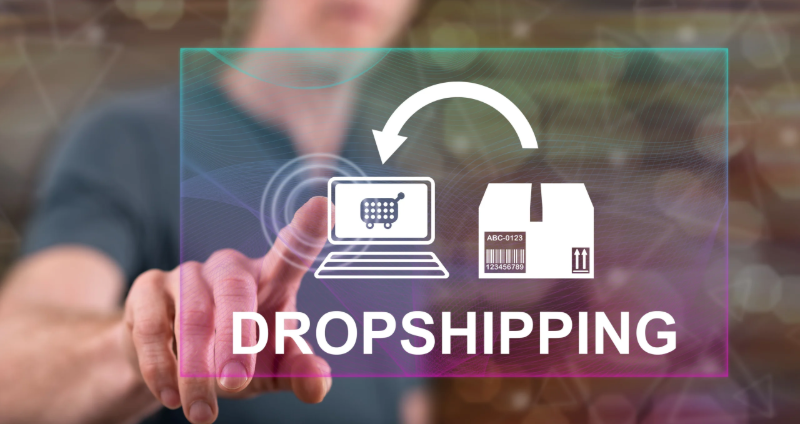
Dropshipping for Beginners: Key Considerations
Product Selection
Choosing the right products is the heart of dropshipping for beginners. You want to pick items that people want to buy, but you also need to make sure you can deliver good quality and service. Start by looking for high-quality products. This helps you build trust with your customers and keeps complaints low. Always order samples and check reviews before you add anything to your shop. You do not want surprises after you start selling.
Think about how much competition there is for each product. If everyone sells the same thing, it is hard to stand out. Try to find a niche where you can offer something special. Join forums and social media groups to see what people talk about and what problems they want to solve. Use tools like Google Trends to spot products that are becoming popular.
Here is a simple checklist to help you choose the best-selling products:
Pick high-quality products and test them yourself.
Check reviews and ratings before you decide.
Look for products with less competition.
Choose reliable suppliers with good shipping times.
Make sure your products fit your business goals.
Use SEO tools to find trending and problem-solving products.
Go for items that create a "wow" effect and encourage repeat purchases.
Prefer lightweight and non-fragile products to avoid shipping problems.
Focus on evergreen products that sell all year.
Test new products on a small scale before you go big.
Tip: Products that are easy to ship and have positive reviews make your life easier and keep your customers happy.
Pricing for Profit
Getting your pricing right is key in dropshipping. You want to make a profit, but you also need to stay competitive. There is no single best way to price your products. Many beginners try different strategies until they find what works.
Here are some popular pricing strategies you can try:
Premium Pricing: Charge more for better quality or service. This works if your products stand out.
Tiered Markup: Use different markups for cheap and expensive products. This gives you flexibility.
Competition-Based Pricing: Check what others charge and set your prices to match or beat them.
Psychological Pricing: Use prices like £9.99 instead of £10. This makes deals feel better.
Bundle Pricing: Sell groups of products together at a small discount. This increases your average order value.
Penetration Pricing: Start with low prices to attract buyers, then raise them once you have loyal customers.
You can also use automation tools to change prices when your supplier changes theirs. This keeps you competitive and protects your profit margins.
Pricing Strategy | Why Use It? |
|---|---|
Fixed Markup | Simple and easy to manage |
Value-Based | Lets you charge more for unique products |
Psychological | Boosts sales with smart price endings |
Bundle | Moves more products and increases order size |
Competitive | Keeps you in the game against other sellers |
Penetration | Helps you get noticed and build trust quickly |
Remember, pricing is not just about covering costs. It also shows your brand’s value and helps you win loyal customers.
Managing Finances
Managing your money well is vital in dropshipping for beginners. Many beginners make the same mistakes, but you can avoid them if you plan ahead. Do not trust suppliers without clear agreements. If you rely on one supplier and they let you down, you could lose orders and customers. Always have a backup supplier for your best-selling products.
Avoid lowering your prices too much just to beat the competition. This can make your products look cheap and hurt your profits. Only big brands can afford to cut prices all the time. Set realistic goals for your dropshipping business. It takes time to make steady profits, so do not expect to get rich overnight.
Focus on products with good profit margins. Cheap items often bring more work and less reward. Use automation tools to track your stock and orders. This saves you time and helps you avoid mistakes like selling out-of-stock products. If you do not monitor your inventory, you risk unhappy customers and financial loss.
Note: Good financial habits help your dropshipping business grow. Use software or a simple spreadsheet to track your sales, costs, and profits. This way, you always know where your money goes.
Legal and Age Requirements
Starting a dropshipping business sounds exciting, but you need to know the legal and age rules before you jump in. These rules help keep you and your business safe. They also make sure you can use all the tools you need, like payment accounts and supplier platforms.
If you are under 18, you might face some extra steps. Most countries and platforms want you to be at least 18 to sign contracts, open business bank accounts, or run ads. Some places let you start younger, but you will need an adult to help with the legal stuff.
Here are some important things to remember if you are a young entrepreneur:
You can start learning about dropshipping as early as 13, but you need a parent or guardian to set up accounts and sign contracts.
Platforms like Shopify, eBay, and most payment processors require you to be 18. If you are younger, your parent must register the account in their name.
Some countries, like the UK, let you start a business at 16. In Indonesia, you can start at 15. In China, you need parental consent if you are under 18.
Banks often offer teen accounts, but a parent must co-own them. This helps you get paid and manage your money.
Running ads on Meta, TikTok, or Google needs you to be 18 or older.
You might find it harder to get supplier approvals or access certain business tools if you are underage.
Tip: If you are under 18, talk to your parents about your business plans. Their support is key for handling contracts, payments, and legal paperwork.
Here’s a quick look at the minimum age requirements in different countries and on popular platforms:
Platform/Country | Minimum Age Requirement | Additional Information |
|---|---|---|
Shopify | 18 years old | Must be 18 to create an account. |
eBay | 18 years old | Must be 18 to use the platform. |
Etsy | 13-17 years old | Allowed with parental involvement. |
Amazon | Under 18 allowed | Possible with parental involvement. |
Singapore | 18 years old | Legal age to operate a business. |
Australia | 18 years old | Legal age to operate a business. |
Canada | No legal age to start | Must be 18 to sign contracts. |
India | 18 years old | Legal age to operate a business. |
New Zealand | 18 years old | Legal age to operate a business. |
France | 18 years old | Legal age to operate a business. |
Philippines | 18 years old | Legal age to operate a business. |
Malaysia | 18 years old | Legal age to operate a business. |
Germany | 18 years old | Legal age to operate a business. |
South Africa | 18 years old | Legal age to operate a business. |
Mexico | 18 years old | Legal age to operate a business. |
China | 14 years old (consent) | Must be 18 to own/control a business. |
Indonesia | 15 years old | Can start and own a business at 15. |
UK | 16 years old | Can work or start a business after 16. |
You can see that most places want you to be 18, but there are a few exceptions. Always check the rules in your country before you start.
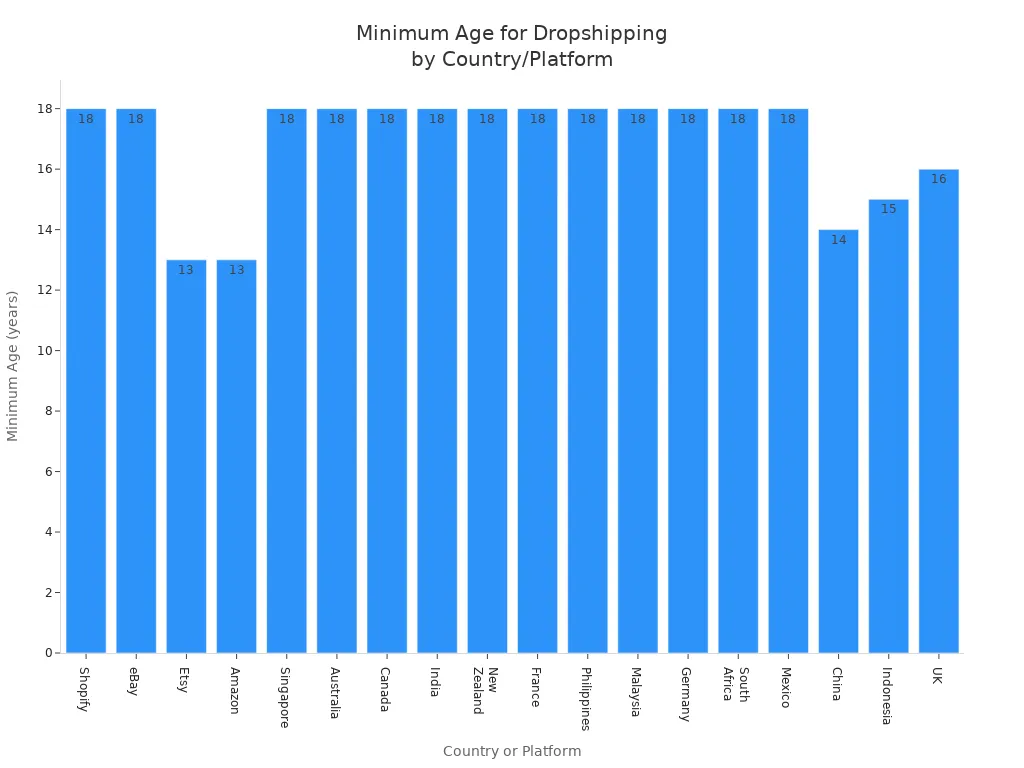
If you are a minor, you might face some challenges. You may not have full access to payment processors or advertising platforms. Some suppliers may not work with you unless an adult is involved. Parental consent is not just a formality—it is a must for legal and financial reasons.
Note: Always keep your business legal. Get help from an adult if you are under 18. This keeps your dropshipping journey smooth and safe.
Start a Dropshipping Business with Little Money
Free Tools and Resources
You do not need lots of money to start dropshipping. There are many free tools that help you begin, even with a small budget. You can use these tools to make your shop, design your brand, and learn new things. Here is a table that shows some free tools you can use:
Category | Free Tools and Resources |
|---|---|
Platform | Free to use, no upfront investment, beginner-friendly |
Product Creation | Product Creator design tool for creating unique products |
Product Catalog | Access to 1,000+ high-quality products |
Graphic Design Tools | Canva, Pixlr for logo and design creation |
Educational Content | Blogs, webinars, podcasts, YouTube videos, guides, and courses |
Marketing Resources | Blog section with marketing hints and tricks |
Support | Help Centre and direct contact options |
Additional Tools | Mockup Generator, AI Image Generator |
Business Naming | Shopify’s free business name generator and naming guide |
You can also find tools like eBay Profit Calculator and Instant Title Builder. These resources help you plan your shop and pick good products. Free guides and blogs give you easy steps to follow, even if you have no money.
Tip: Use free learning and design tools to make your shop look good from the start.
Using Free Trials
Worried about costs? Free trials can help you start dropshipping. Most platforms let you build your shop and try features before you pay. This helps you learn and see what you like.
Aspect | Benefits | Limitations |
|---|---|---|
Trial Setup | Set up and customise your shop without paying straight away | Checkout and selling features are disabled during the standard trial |
Trial Duration | Standard trial lasts 3 days; some special offers last longer | Standard trial is short (3 days) |
Selling Capability | Access to key features and app installation during trial | You need to upgrade to a paid plan to actually sell products |
Payment Information | No credit card needed for basic free trial | Extended offers may need card details |
Trial Extension Options | You can sometimes extend your trial by contacting support | Extensions are limited and not always guaranteed |
Post-Trial Billing | No charges if you don’t pick a plan; account is frozen but not billed | Your shop stays inactive until you subscribe |
You can use these trials to test your shop and try different designs. Free trials let you practise and learn without spending money. You cannot sell until you pay, but you can still learn a lot in those first days.
Low-Cost Marketing
You do not need much money to get your first sales. Try smart, cheap ways to tell people about your shop. Here are some ideas to help you start:
Run ads on Facebook, Google, Instagram, or TikTok with a small budget. Even £10 can bring visitors.
Make ads that talk to your customer’s needs. Try different pictures and words to see what works best.
Start an email list right away. Send emails to keep customers coming back.
Work with micro-influencers. They have loyal fans and often cost less.
Set up an affiliate programme. Give rewards to people who bring you sales.
Use free content marketing. Write blog posts, share tips, and answer questions in your niche.
Be active on social media. Post often and reply to comments to build trust.
Check what works and change what does not.
Mixing free and paid ways helps you grow your shop quickly. You can start dropshipping with almost no money and still find your first customers.
Note: Your success depends on your product and how you set up your shop. Keep testing and improving your marketing to get better results.

Common Mistakes in Dropshipping
Poor Niche Choice
Choosing the wrong niche is one of the biggest mistakes you can make in dropshipping. Many beginners pick niches that are too broad. You might feel tempted to sell all sorts of products, like electronics and clothing together. This makes it hard for you to build a strong brand. Customers get confused and may not trust your shop.
When you choose a broad niche, you struggle to find and target the right audience. Your adverts do not work well, and your marketing budget disappears quickly. You also find it tough to rank on search engines because your shop does not look like an expert in any area. Some people pick niches based on trends or personal interests, but they forget to check if these products will sell for a long time. Others rely only on dropshipping suppliers from places like AliExpress, without doing proper market research. If you do not focus on what your customers need, you end up with a niche that does not solve real problems.
Here are some common mistakes when picking a niche:
Selling unrelated products in one shop
Not knowing who your target customer is
Ignoring long-term growth and only chasing trends
Relying on one source for products and not checking the wider market
Forgetting to solve customer problems
Tip: Always research your niche and think about your customer’s needs before you choose your products.
Ignoring Supplier Quality
You might think all dropshipping suppliers are the same, but this is not true. If you pick poor-quality suppliers, your business will suffer. Bad suppliers send out low-quality products, which leads to unhappy customers and lots of returns. They might ship orders late or run out of stock without warning. This causes delays and makes your customers lose trust in your shop.
Let’s look at what happens when you ignore supplier quality: 1. Customers get upset because they receive poor products. 2. Late shipments and stock issues make people angry. 3. Bad reviews start to appear, and your reputation drops. 4. More order mistakes mean more returns and extra work for you. 5. If you cannot talk to your suppliers easily, you face more problems with orders and shipping. 6. Inconsistent product quality makes it hard to keep loyal customers. 7. You have less control over packaging and the final customer experience.
You depend on your dropshipping suppliers for your business to run smoothly. If you do not check their quality, your shop will struggle to grow.
Note: Always test your suppliers before you trust them with your orders. Good communication and reliable service are key.

Underpricing Products
Setting your prices too low might seem like a good way to get sales, but it often backfires. When you underprice your products, customers may think they are low quality. This hurts your brand and makes people less likely to trust your shop. You need to find a balance between offering good value and showing that your products are worth buying.
If you price your products too cheaply, you also risk losing money. You might not cover your costs, and you will struggle to grow your business. Fair pricing helps you build trust and keeps your dropshipping business healthy.
Remember: Customers want good value, but they also want to feel confident in what they buy. Set your prices to reflect the quality and service you offer.
Neglecting Customer Service
You might think customer service is not a big deal in dropshipping. You just list products, take orders, and let your suppliers do the rest. But if you ignore customer service, your business will struggle. People remember how you treat them, not just what you sell.
When you run a dropshipping shop, you face some unique customer service challenges. You do not control the stock or the shipping. Sometimes, things go wrong that you cannot fix right away. Here are some of the most common problems you will face:
Delays and long shipping times, especially if your supplier is overseas.
Product quality issues, since you never see the items before they reach your customer.
Handling returns, which can get tricky when you must go through your supplier.
Miscommunication between you, your supplier, and your customer.
Stockouts or inventory problems, because you do not manage the warehouse.
Managing customer expectations about delivery and returns.
Finding reliable suppliers who keep their promises.
If you do not handle these problems well, your customers will get upset. They might leave bad reviews or ask for refunds. Some will never shop with you again. You could even lose your payment accounts if you get too many complaints.
So, what can you do to avoid these mistakes? Start by being honest and clear. Always tell your customers how long shipping will take. If there is a delay, let them know right away. Use simple language and reply quickly to questions. People want to feel heard and respected.
Set up clear shipping and return policies on your website. Make sure your customers can find them easily. This helps protect you and your buyers. If a product arrives late or damaged, apologise and offer a solution. Sometimes, a small discount or a replacement can turn an unhappy customer into a loyal fan.
You should also use tools that help you track orders and manage stock in real time. Many platforms now offer updates that show when an item is out of stock or delayed. This helps you keep your promises and avoid surprises.
Here are some quick tips to boost your customer service:
Respond to messages within 24 hours.
Use friendly, simple words in every reply.
Keep your customers updated about their orders.
Work with suppliers who have good reviews and fast shipping.
Ask for feedback and use it to improve your shop.
Tip: Great customer service builds trust. Happy customers come back and tell their friends. In dropshipping, your service is your brand.
If you focus on customer service, you will stand out from other dropshippers. You will build a shop that people trust and recommend. That is how you grow a real business, not just make quick sales.

Overcoming Dropshipping Challenges
Starting a dropshipping business feels exciting, but you will face some bumps along the way. Let’s look at the most common challenges and how you can handle them like a pro.
Supplier Issues
You rely on your suppliers for everything. If they mess up, your business takes the hit. Sometimes, suppliers run out of products or change prices without warning. You might even find that the quality drops after your first few orders.
Here’s how you can deal with supplier problems:
Always test your suppliers before you trust them with lots of orders. Order samples and check the quality yourself.
Keep a backup supplier for your best-selling products. If one supplier lets you down, you can switch quickly.
Communicate often. Ask your supplier about stock levels and any changes to their products.
Use supplier directories that vet their sellers. This lowers your risk of scams or poor service.
Tip: Build a good relationship with your suppliers. A friendly message or quick thank you can go a long way.
Shipping Delays
Shipping delays frustrate your customers. Sometimes, products take longer to arrive because of customs, busy seasons, or mistakes at the warehouse. You cannot control every step, but you can manage your customer’s expectations.
Try these steps to reduce shipping headaches:
Choose suppliers with warehouses close to your main market. Local suppliers ship products faster.
Show clear delivery times on your website. If a product takes three weeks, let your customers know before they buy.
Track every order. Share tracking numbers with your customers so they can see where their products are.
Update your customers if there is a delay. A quick email can stop complaints before they start.
Note: Fast shipping makes your shop stand out. If you can, offer express options for customers who want their products quickly.
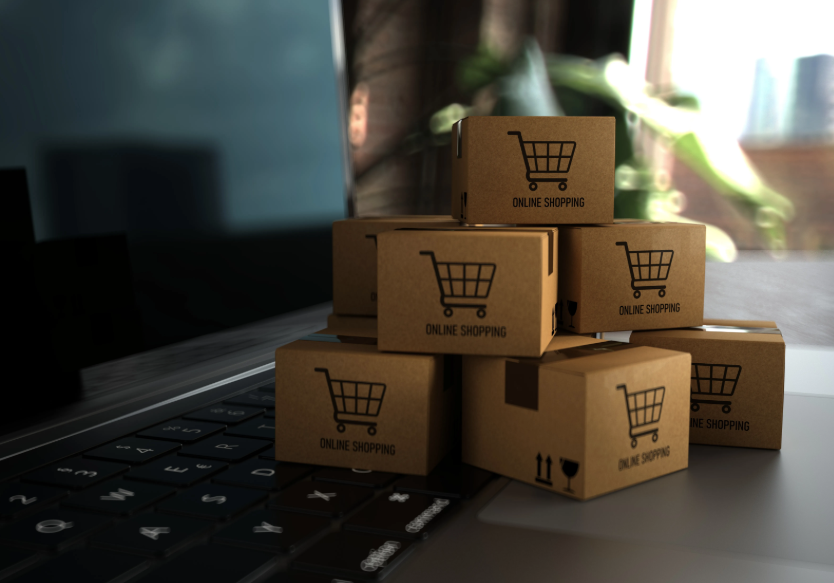
Handling Returns
Returns are part of every dropshipping business. Sometimes, customers change their minds or get a faulty product. Handling returns well keeps your reputation strong.
Here’s what you can do:
Set a clear returns policy. Make it easy to find on your website.
Work with suppliers who accept returns and refunds. Check their rules before you list their products.
Respond quickly to return requests. A fast reply shows you care.
Offer solutions. If a product arrives damaged, send a replacement or refund.
Keep records of every return. This helps you spot patterns and fix problems with certain products.
Tip: Good return service turns unhappy customers into loyal fans. They will remember how you helped them, not just the problem with the product.
You will face challenges in dropshipping, but you can overcome them. Stay organised, talk to your suppliers, and always put your customers first.
Costs and Profit Expectations
Start-Up Costs
You might wonder how much money you need to start your own dropshipping business. The good news is, you can begin with a small budget or go bigger if you want more features and faster growth. Here’s a quick look at the main costs you’ll face when you get started:
Cost Category | Description | Cost Range |
|---|---|---|
Business Startup | Legal formation (LLC or similar) | $132 - $340 (one-time) |
Ecommerce Platform | Shopify monthly plans | $39 - $439 per month |
Domain Name | Annual domain registration | $8 - $20 per year |
Store Setup | Store creation and design | $0 - $440 (one-time) |
Product Research | Tools and subscriptions | $0 - $39 per month |
Advertising | Marketing and ads | $0 - $4,000 per month |
Supplier Fees | Dropshipping supplier costs | $0 - $40 per month |
Most people spend between $150 and $700 to get started. Your monthly costs can range from $150 to $4,300, depending on how much you spend on ads and extra tools.
You can choose a budget plan that fits your needs. Here’s a simple table to help you decide:
Budget Plan | Key Components | Approximate Cost Range |
|---|---|---|
Low Budget DIY | Free theme, limited ads, do it all yourself | Around $500 |
Moderate Budget | Paid theme, some design help, more testing | Around $1,000 |
Mid-Level Budget | More product tests, better apps, extra support | Around $3,000 |
High Budget | Strong launch, lots of ads, legal setup | Around $10,000 |
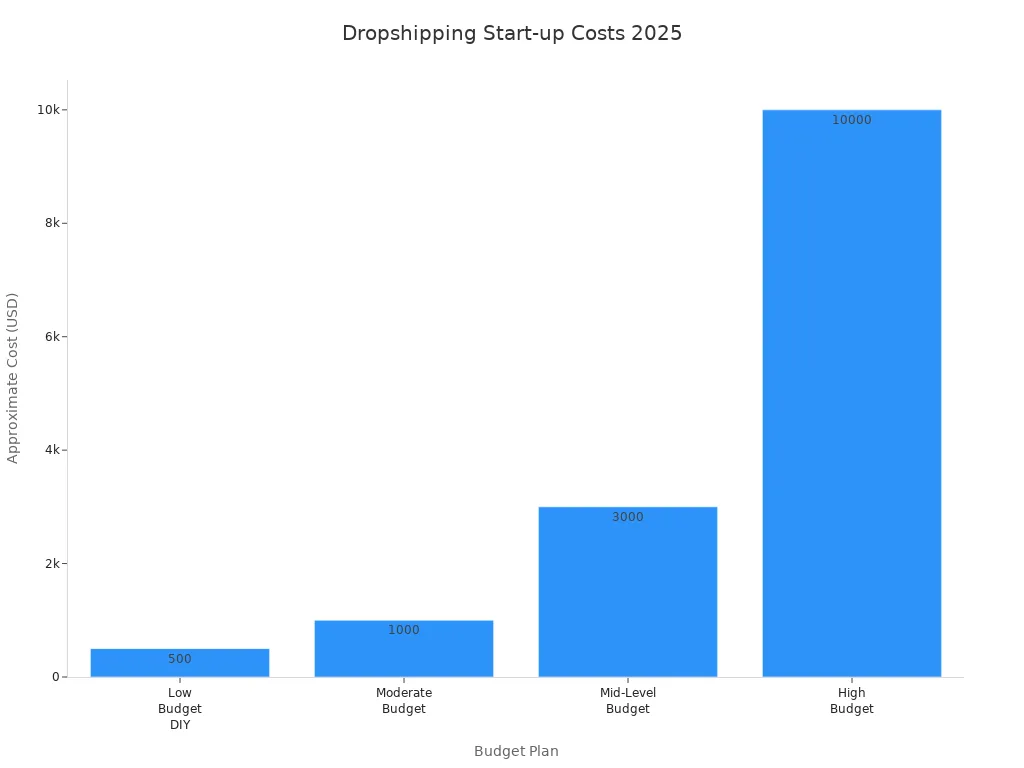
Tip: You don’t need to spend a lot to start. Many people launch their first shop with less than £500.
Ongoing Expenses
Once your shop is live, you’ll have some regular costs to keep things running. These are the main ongoing expenses you should expect:
Ecommerce platform fees (like Shopify or WooCommerce)
Domain renewal (usually once a year)
Product research tools (if you use paid ones)
Advertising and marketing (this can be as little or as much as you want)
Supplier fees (some suppliers charge monthly or per order)
Apps and plugins (for automation, email, or analytics)
Refunds and returns (sometimes you need to cover these costs)
You can control many of these costs by starting small and only adding new tools when you need them. If you keep your ad spend low and use free resources, your monthly costs can stay under £200.
Note: Always track your spending. This helps you see where your money goes and keeps your dropshipping business healthy.
Time to Profit
You probably want to know how long it takes to make money from your dropshipping business. Most people need between three and six months to figure out what works best for their shop. You’ll spend this time testing products, trying different ads, and learning about your customers.
Some dropshippers who work more than 20 hours a week see their first profits in just over two months. The first month of profit is often around $229. If you keep learning and improving, you can start making steady profits in six months to a year. Your results depend on how much time you put in, how well you market your shop, and how quickly you learn from your mistakes.
Remember: Success doesn’t happen overnight. Stay patient, keep testing, and celebrate every small win along the way.
Final Checklist Before You Start Dropshipping
Before you open your store to the world, you want to make sure everything works well. This checklist helps you avoid common mistakes and gives you confidence for your first order.
Test Your Store
You should always test your store before you launch. Go through the shopping process as if you are a customer. Add products to your basket, check the product pages, and try the checkout. Make sure every button works. Look for spelling mistakes or broken links. If you find a problem, fix it now. Ask a friend or family member to place a test order. They might spot things you missed.
Tip: Use different devices like a phone, tablet, and computer. Your store should look good everywhere.
A quick test can save you from losing your first real order. You want your customers to have a smooth experience from start to finish.
Legal Compliance
You need to follow the rules for your country and your market. Check that your business registration is complete. Make sure your store has clear terms and conditions, privacy policy, and return policy. These pages protect you and your customers. If you collect customer data, follow GDPR or other local laws. Always show your contact details on your store.
Legal Page | Why You Need It |
|---|---|
Terms & Conditions | Sets the rules for your store |
Privacy Policy | Explains how you use data |
Return Policy | Tells customers about returns |
If you sell special products, check if you need extra licences. You want to avoid legal trouble after your first order.
Prepare for Orders
You want to be ready when your first order comes in. Set up email alerts so you never miss a new order. Check your supplier’s stock levels every day. Make sure you know how to place an order with your supplier quickly. Prepare your welcome email for new customers. This small step makes your store feel professional.
Note: Keep your phone or email close by. Fast replies to customers help you build trust.
Have a plan for what to do if something goes wrong with an order. Write down the steps for refunds or returns. This way, you will not panic if a problem comes up.
A final checklist helps you feel ready. When you test your store, follow the law, and prepare for orders, you start your dropshipping journey with confidence.
You have seen how to start your own successful dropshipping business in 2025. Take each step, use free resources, and learn as you go. Every successful dropshipping journey begins with a single sale. Stay patient, keep testing new ideas, and never give up. You can build something great if you start today. Ready to launch your shop? Your first order could be just around the corner!
FAQ
What is the minimum amount of money I need to start dropshipping?
You can start dropshipping with less than £100 if you use free trials and free tools. You only pay for your domain and a basic plan. You do not need to buy stock upfront.
Can I do dropshipping as a student or while working full-time?
Yes, you can. Dropshipping is flexible. You can run your shop after school or work. Many people start part-time and grow their business when they have more time.
Do I need to register a business before I start selling?
You should register your business before you take your first order. This keeps you legal and helps you open payment accounts. Check your country’s rules for small businesses.
How do I handle returns and refunds in dropshipping?
You contact your supplier when a customer wants a return. The supplier gives you instructions. You then update your customer. Always set a clear returns policy on your website.
Is dropshipping legal in the UK and Europe?
Yes, dropshipping is legal in the UK and Europe. You must follow consumer laws, pay taxes, and protect customer data. Always check local rules before you start.
What happens if my supplier runs out of stock?
If your supplier runs out, you should remove the product from your shop. You can also find a backup supplier. Always tell your customers if there is a delay or problem.
Can I use my own branding with dropshipping products?
Many suppliers offer private labelling or custom packaging. You can add your logo and brand colours. This helps your shop stand out and builds trust with your customers.

TangBuy: A Smarter Way to Dropship in 2025
If you're looking to stay competitive with dropshipping in 2025, speed and trend-awareness are key. TangBuy helps you stay ahead with real-time product trends, fast fulfilment, and factory-direct sourcing. With over 1 million ready-to-ship items, 24-hour order processing, and seamless Shopify integration, TangBuy makes it easier to test, scale, and succeed in today's fast-moving eCommerce landscape.
